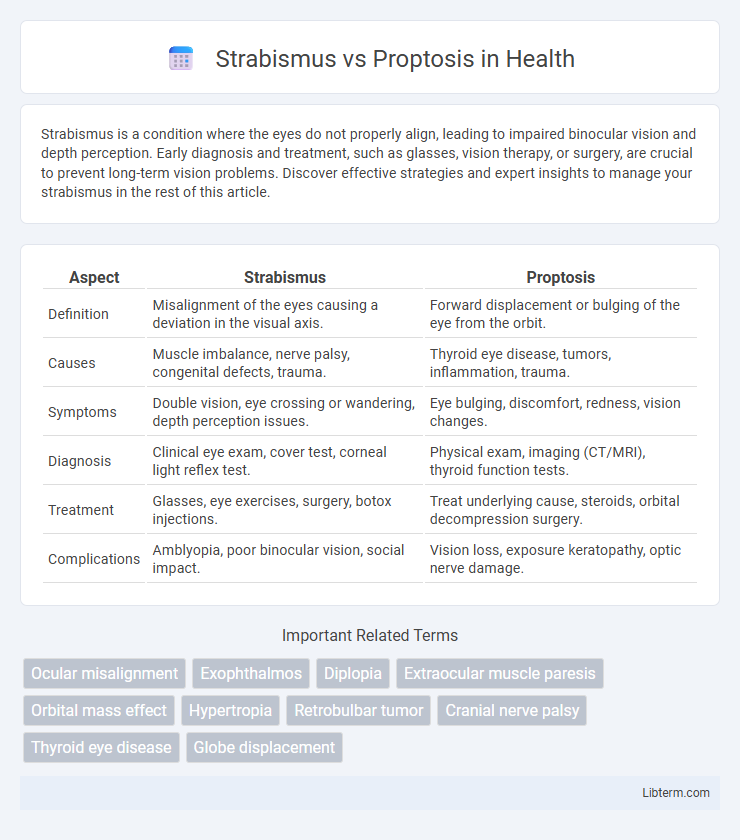Strabismus is a condition where the eyes do not properly align, leading to impaired binocular vision and depth perception. Early diagnosis and treatment, such as glasses, vision therapy, or surgery, are crucial to prevent long-term vision problems. Discover effective strategies and expert insights to manage your strabismus in the rest of this article.
Table of Comparison
| Aspect | Strabismus | Proptosis |
|---|---|---|
| Definition | Misalignment of the eyes causing a deviation in the visual axis. | Forward displacement or bulging of the eye from the orbit. |
| Causes | Muscle imbalance, nerve palsy, congenital defects, trauma. | Thyroid eye disease, tumors, inflammation, trauma. |
| Symptoms | Double vision, eye crossing or wandering, depth perception issues. | Eye bulging, discomfort, redness, vision changes. |
| Diagnosis | Clinical eye exam, cover test, corneal light reflex test. | Physical exam, imaging (CT/MRI), thyroid function tests. |
| Treatment | Glasses, eye exercises, surgery, botox injections. | Treat underlying cause, steroids, orbital decompression surgery. |
| Complications | Amblyopia, poor binocular vision, social impact. | Vision loss, exposure keratopathy, optic nerve damage. |
Introduction to Strabismus and Proptosis
Strabismus is a condition characterized by the misalignment of the eyes, where one or both eyes may turn inward, outward, upward, or downward, affecting binocular vision and depth perception. Proptosis, also known as exophthalmos, refers to the abnormal protrusion or bulging of one or both eyeballs, often caused by inflammation, tumors, or thyroid eye disease. Both conditions impact ocular appearance and function but differ in their underlying mechanisms, with strabismus primarily involving extraocular muscle imbalance and proptosis resulting from orbital tissue abnormalities.
Definition and Key Differences
Strabismus is a condition characterized by the misalignment of the eyes, where they do not properly coordinate to focus on the same point, while proptosis refers to the abnormal protrusion or bulging of one or both eyes from the orbit. Key differences include strabismus primarily affecting eye alignment and binocular vision, whereas proptosis involves increased forward displacement of the eyeball, often caused by orbital inflammation, tumors, or thyroid eye disease. Diagnosis of strabismus focuses on assessing ocular motility and alignment, whereas proptosis evaluation requires imaging studies to determine the underlying orbital pathology.
Causes of Strabismus
Strabismus is primarily caused by imbalances in the eye muscles, neurological disorders, or abnormalities in the brain's control of eye movements, leading to misalignment of the eyes. Genetic factors, trauma, and conditions such as cerebral palsy or stroke can also contribute to the development of strabismus. Unlike proptosis, which involves the protrusion of the eyeball typically due to trauma, inflammation, or thyroid eye disease, strabismus centers on the dysfunction of ocular muscle coordination.
Causes of Proptosis
Proptosis, or the abnormal protrusion of the eye, is primarily caused by conditions such as thyroid eye disease (Graves' orbitopathy), orbital tumors, inflammation (orbital cellulitis), and trauma leading to hemorrhage or edema. Unlike strabismus, which is a misalignment of the eyes due to muscle imbalance or nerve issues, proptosis involves increased orbital content or volume displacement. Accurate diagnosis of proptosis requires imaging techniques like CT or MRI to identify the underlying cause and guide appropriate treatment.
Clinical Presentation and Symptoms
Strabismus presents with misalignment of the eyes, leading to double vision (diplopia), eye strain, and difficulty with depth perception. Proptosis is characterized by the abnormal protrusion of one or both eyeballs, causing visible bulging, eye redness, and potential vision impairment due to exposure or optic nerve compression. Both conditions may result in impaired ocular function but differ significantly in clinical signs and underlying causes.
Diagnostic Approaches
Strabismus diagnosis primarily involves a comprehensive eye examination including the cover-uncover test, Hirschberg test, and assessment of ocular motility to detect misalignment and determine the affected muscles. Proptosis evaluation relies on clinical measurement using exophthalmometry, imaging studies such as CT or MRI to assess orbital structure abnormalities, and thyroid function tests to identify underlying causes like thyroid eye disease. Differential diagnosis between the two requires careful analysis of ocular alignment, globe protrusion, and imaging findings to guide appropriate management.
Treatment Options for Strabismus
Strabismus treatment primarily involves corrective glasses, eye patching, vision therapy, and in some cases, surgical intervention to realign the eye muscles. Botox injections can be used as a temporary measure for specific types of strabismus by weakening overactive muscles. Early diagnosis and individualized treatment plans improve the chances of restoring binocular vision and preventing amblyopia.
Treatment Options for Proptosis
Treatment options for proptosis primarily depend on the underlying cause, such as thyroid eye disease, tumors, or inflammation. Medical management may include corticosteroids or immunosuppressive agents to reduce inflammation, while surgical interventions like orbital decompression or tumor removal are considered for severe or non-responsive cases. Early diagnosis and tailored therapy are crucial to prevent vision loss and improve ocular alignment and cosmetic appearance.
Prognosis and Potential Complications
Strabismus, characterized by misalignment of the eyes, generally has a favorable prognosis when treated early with methods such as corrective lenses, patching, or surgery, though untreated cases may lead to amblyopia or impaired depth perception. Proptosis, the abnormal protrusion of the eye, often signals underlying conditions like thyroid eye disease or orbital tumors, and its prognosis depends on the severity and cause, with potential complications including exposure keratopathy, optic neuropathy, and vision loss. Early diagnosis and appropriate intervention are critical in both conditions to minimize long-term visual impairment and optimize functional outcomes.
When to Seek Medical Attention
Seek medical attention for strabismus if there is persistent eye misalignment, double vision, or difficulty focusing, especially in children, to prevent vision loss. For proptosis, immediate evaluation is crucial if there is sudden eye bulging, eye pain, redness, or vision changes, as it may indicate underlying orbital infection, inflammation, or tumors. Early diagnosis and treatment are vital to avoid complications such as amblyopia in strabismus or optic nerve damage in proptosis.
Strabismus Infographic

 libterm.com
libterm.com